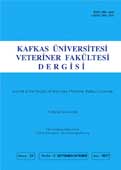
This journal is licensed under a Creative Commons Attribution-NonCommercial 4.0 International License
Kafkas Üniversitesi Veteriner Fakültesi Dergisi
2017 , Vol 23 , Issue 5
Surgical Treatment Results of Young and Adult Cats with Pectus Excavatum
1Faculty of Veterinary Medicine, University of Istanbul, Department of Surgery, TR-34320 Avcilar, Istanbul - TURKEY2For-Vet Veterinary Clinic, TR-34844 Maltepe, Istanbul - TURKEY DOI : 10.9775/kvfd.2017.17501 Pectus excavatum (PE) is an uncommon, congenital thoracic wall deformity that has been previously documented in a variety of species. Most of the time, the preferred treatment modality is surgical. External and internal splints may also be used according to the age of the patient and pliability of the sternum. In this study, the authors have aimed to share the clinical and radiographic results obtained in the treatment of PE by traditional external splintage, internal splintage and sternal turnover techniques in cats. For this purpose, PE was treated using the sternal turnover technique in 8 patients, internal splint in 1 patient and external splint in 9 patients. Ages of the patients varied between 2-24 months. The external splint technique was preferred to treat cats aged younger than 12 months. Frontosagittal indices (FSI), vertebral indices (VI) and clinical severity scores (CSS) were determined before and after surgical interventions. Mean FSI, VI and CSS values were 2.1, 10.0 and 0.8 and 1.8, 11.3 and 0.4 in external splint and sternal turnover groups, respectively. At the end of the study, FSI and VI values did not reach the reference interval, however, CSS values were improved in both the external splint and sternal turnover groups. In conclusion, results of the sternal turnover technique, used for the first time in feline patients with PE, were satisfactory even though complete recovery in FSI and VI values could not be achieved. Also, in the opinion of the researcher, results of using sternal turnover technique in feline PE patients younger than 12 months of age should be further investigated. Keywords : Pectus Excavatum, External Splint, Sternal Turnover, Cat










